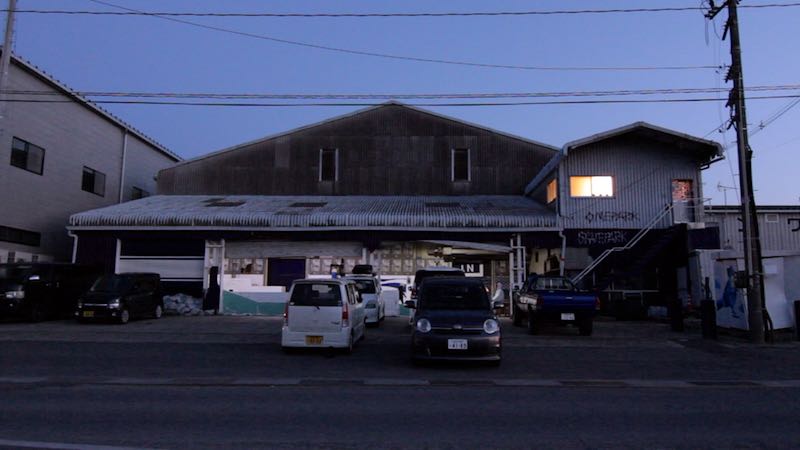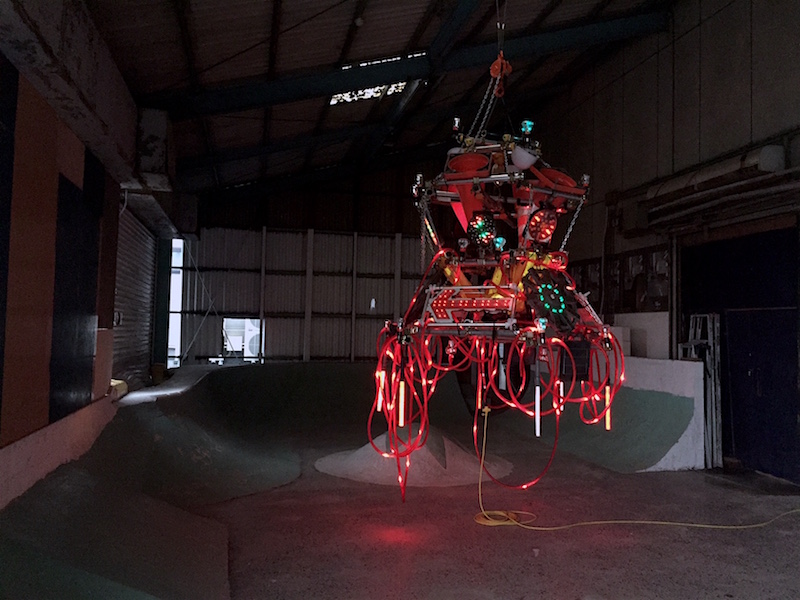video installation and sculpture
A project to create a skatepark on the street, imitating a construction site at night. In the tsunami-affected area of Ishinomaki City, Miyagi Prefecture, a project to create a skatepark on the street, which is an imitation of a construction site at night.
note
・Local skaters from Ishinomaki cleaned up a fishing warehouse destroyed by the 2011 tsunami to create a DIY skate park called “ONEPARK”. As one of the best indoor skate parks in the Tohoku region, it has become a gathering place for many people, and SIDE CORE and EHS were invited to hold an exhibition at the Reborn-Art Festival in 2017. The artists are professional skater Takahiro Morita, skater and artist BABU, photographer Nampei Akaki, graffiti writer STANG, and artist BIEN.

・Just before the exhibition, ONEPARK was closed due to a fire department inspection. Skateboarding indoors was banned and the exhibition was cancelled. It was decided that all the artists would change their policy to “exhibitions held around the skate park without using the main floor”.
・The exhibition of EHS’s works was to set up a screen in the closed skate park and watch the images from the entrance. The sound of the night city and skating echoed through the pitch-black skate park. The repetition of skating sounds like the sound of waves.

・The sculpture is a chandelier made of construction equipment used in the filming and the costumes worn by the skaters. At night, only construction lights glow outside the skate park, but this chandelier has become a landmark, illuminating the street at night.

・The skaters in the film are local junior and senior high school students and their mentors. One of them started skating with ONEPARK and now he’s working hard to become a pro skater.
・The idea of using a construction site was an existing plan of the EHS. Japanese construction sites are as flashy and strange as a shiny theme park. The need to put in more lighting equipment than necessary, and the reason such regulations are so stringent, is because of unfair rules that allow huge general contractors to bid preferentially. However, after the earthquake, construction work increased and small companies had to take the lead in road construction, so the construction equipment rental company grew. Sendai-Meiban, the company that provided the construction supplies, is a construction company in Miyagi Prefecture that has grown up since the earthquake and is now expanding its business throughout Japan.
・After the earthquake, EHS was already paying attention to the Sendai-Meiban construction supplies.The Sendai-Meiban products have a special system that synchronizes the flashing of the lights on all the light fixtures. To give a concrete example, let’s say there were 100 colored cones lined up on the street, and all the lights blinked at the same count. The lights have an electronic clock system built into the lighting, which blinks at the same count for eastern Japan.The flashes seen in Tokyo and Ishinomaki are synchronized, that is, the scenery is connected.
・Skateboarding was adopted as an official competition from the Tokyo Olympics, but skateboarding on the streets was banned in Shibuya, Tokyo. Of course, a lot of skaters are born on the streets.
・A seawall (a huge levee built after the tsunami) appears in the video, contrasting with the skate section. Skaters Takahiro Morita and BABU shot a skate video on the seawall when they visited the site for a preview. At the time, local skaters avoided skating on seawalls because of the memories of the tsunami, but after seeing Morita and BABU, they started skating on seawalls.
・Takahiro Morita says that at the time of the San Francisco earthquake in the U.S., an American Thraser magazine ran an earthquake memorial feature in which skaters did tricks on the broken ground.
・In tsunami-affected areas, roads are often blocked or liberated depending on the construction process. The road you took yesterday will not be available tomorrow.The reason for the delay in construction is the shortage of manpower for the Tokyo Olympics and the fluctuating prices of materials.
・Skateboarding is usually derived from surfing culture, but in Tohoku, snowboarding was popular, and skateboarding spread. The skate system is completely different for surfing and snowboarding, and those in the Northeast who were used to snowboarding had a difficult time getting used to skateboarding.